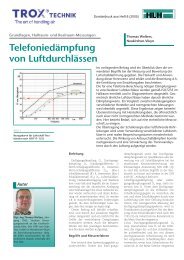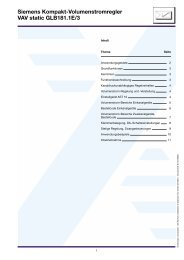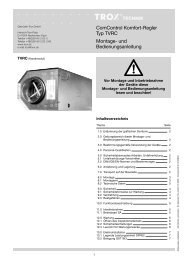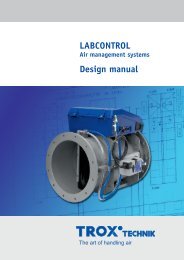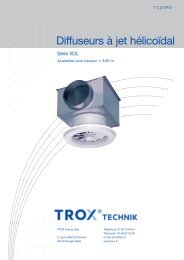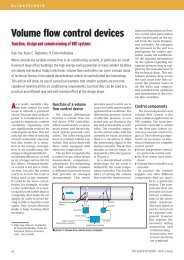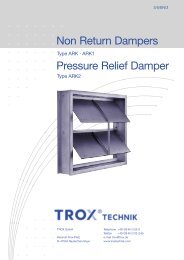ASHRAE Journal: Designing Chilled Beams for Thermal ... - TROX
ASHRAE Journal: Designing Chilled Beams for Thermal ... - TROX
ASHRAE Journal: Designing Chilled Beams for Thermal ... - TROX
Create successful ePaper yourself
Turn your PDF publications into a flip-book with our unique Google optimized e-Paper software.
primary airflow rate or 350 cfm (595 m 3 /h). The temperature<br />
(T OC ) of the air leaving the beam’s integral cooling coil can<br />
be conservatively estimated as 1°F (0.6°C) warmer than its<br />
mean chilled water temperature, which is the average of the<br />
entering and leaving chilled water temperatures. In fact, the<br />
leaving air temperature would typically be at least 2°F to 4°F<br />
(1°C to 2°C) higher than the coil mean water temperature. The<br />
beam manufacturer has this in<strong>for</strong>mation as well as the beam’s<br />
IR. Upon identifying the primary air temperature (T PA ), the<br />
temperature (T Z ) leaving the beam as well as the initial room<br />
to supply air temperature difference (ΔT Z ) can be estimated<br />
using Equations 1 and 2.<br />
T Z = [T PA + (T OC × IR)] / (IR+1) (1)<br />
or, <strong>for</strong> this example,<br />
ΔT Z = T ROOM – T Z (2)<br />
T Z = [55°F + (60°F × 2.5)] / (2.5 + 1) = 58.6°F and<br />
ΔT Z = 75°F – 58.6°F = 16.4°F<br />
The initial velocity (V O ) of a supply airstream leaving the<br />
discharge slot can be calculated by dividing the supply airflow<br />
rate leaving each slot (<strong>for</strong> two-way beams this is 0.5 x Q S ) by the<br />
effective area of that slot. If the effective area is not available,<br />
V O can be conservatively estimated as 450 fpm (2.3 m/s) <strong>for</strong> the<br />
purposes of this calculation. The local temperature difference<br />
(ΔT X ) between the room and the supply airstream at any point<br />
along its travel can be estimated by Equation 3. 4<br />
ΔT X = 0.8 × ΔT Z × (V X / V O ) (3)<br />
For a beam with an initial discharge velocity (V O ) of 450 fpm<br />
(2.3 m/s) and an initial supply to room temperature differential<br />
(ΔT Z ) of 16.4°F (9.1°C), the local temperature differential (ΔT X )<br />
at the point coincident with a 50 fpm (0.25 m/s) terminal velocity<br />
is about 1.4°F (0.9°C). Referring to Figure 2, this predicts<br />
that less than 20% of the occupants would be dissatisfied with<br />
these local velocity/temperature conditions.<br />
As the region near the outside walls is not defined as part<br />
of the occupied zone, local velocities and temperatures do not<br />
generally affect occupant thermal com<strong>for</strong>t. Care should still be<br />
taken that they are not so high that they can affect processes<br />
(e.g., fume hoods) along the outer wall and that they are sufficient<br />
to provide adequate heating where applicable. Chapter 56<br />
of the 2007 <strong>ASHRAE</strong> Handbook—HVAC Applications 5 recommends<br />
that outlets used <strong>for</strong> perimeter heating be selected and<br />
located such that their isothermal throw to 150 fpm (0.75 m/s)<br />
extends at least halfway down the outside surface or to a level<br />
5 ft (1.5 m) above the floor, whichever is greater.<br />
The area of greatest draft risk usually occurs directly below<br />
the point where two opposing airstreams collide. Figure 1 illustrates<br />
such a point and defines the collision velocity as V C .<br />
If the velocity (V C ) of the colliding airstreams is of sufficient<br />
velocity (greater than 100 fpm or 0.5 m/s), some of the velocity<br />
and temperature differential of the airstreams is dissipated by the<br />
collision and the velocity (V H1 ) at the point where the airstream<br />
Figure 2: Percentage of occupants objecting to drafts in air. 3<br />
enters the occupied zone is reduced accordingly. Figure 3 can<br />
be used to estimate the velocity at the entry point <strong>for</strong> various<br />
collision velocities and vertical distances (H1) between the<br />
point of collision and the top of the occupied zone. This figure<br />
illustrates that the velocity (V H1 ) entering the occupied zone<br />
directly below the point of collision of two airstreams will be<br />
less than half the collision velocity (V C ) if distance H1 (the<br />
distance between the ceiling and the top of the designated occupied<br />
zone) is greater than or equal to 3.5 ft (1.1 m).<br />
In cases where the collision velocity (V C ) is 100 fpm (0.5 m/s)<br />
V H1 would be less than or equal to 50 fpm provided H1 is greater<br />
than 3.5 ft (1.1 m). In cases where H1 is greater than 3.5 ft (1.1<br />
m), active chilled beams should be sized and located so that<br />
their throw to a terminal velocity of 100 fpm (0.5 m/s) does not<br />
exceed half the distance to another beam with an opposing blow.<br />
In cases where the collision velocity (V C ) is 150 fpm (0.75<br />
m/s), V H1 is less than or equal to 50 fpm provided H1 is greater<br />
than 6 ft (1.8 m). Active beams <strong>for</strong> which H1 is greater than<br />
6 0 A S H R A E J o u r n a l a s h r a e . o r g O c t o b e r 2 0 0 9




